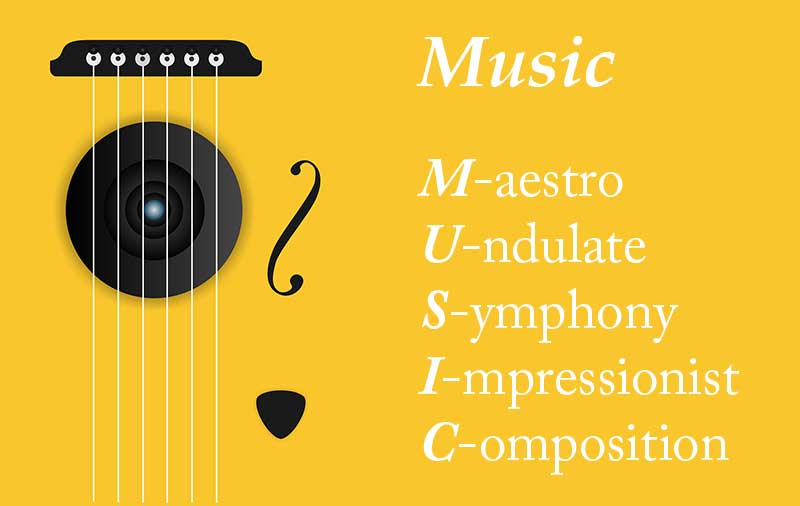An acrostic poem is a form of poetry in which the first letters of each line represent a word, phrase, name, or short sentence when read vertically. The term displays the message or subject of the poem but does not need to rhyme or follow a stanza pattern. Some acrostic poems use middle letters or the last letters to spell the word, phrase, name, or sentence.

One of the main rules of acrostic poetry is that it must have the first, middle, or last letters of each line spelling a word, phrase, or short sentence. The topic represented is usually read from top to bottom to allow for the poem to flow agreeably. Each line in the poem must have the first letter capitalized.
Types of Acrostic Poems
ABC
Alphabet acrostics (ABC poems) are poems in which the first letter of each couplet or stanza spells out the entire alphabet's 26 letters.
Abecedarius
Alphabetic acrostics, also known as the "abecedarius," are characterized by simply spelling out letters in alphabetic order. This is different than an alphabet poem that uses all 26 letters of the alphabet. This kind of acrostic is seen in chapters in several books of the Bible, such as Proverbs, Psalms, Lamentations, etc.
Double Acrostic
Double acrostic refers to the scenario where both the first and last letters in each line spell out the theme of the poem. Usually, the first letters in the opening stanzas give a hint to the word created by the last letters in the second stanzas. This kind of acrostic poetry is believed to have started in the 1800s. It is usually seen in the works of medieval monks, renaissance poets, and ancient Greek and Latin authors.
Multiple Acrostics
Multiple acrostics refers to those acrostics that can be organized within the stanzas to pass the message. Behold, Oh God!, by William Browne is a classic example of multiple acrostics. The letters are capitalized in some instances within the stanzas to spell words and sentences. Other words are written in italics, lines shifted from left to right, and other words are written in red.
Examples of Acrostic Poems
Since the 2nd century BC, several notable poems using acrostics have been written. This is especially true during the Alexandrine period in Greece and the renaissance period in Europe.
The National Anthem of Netherlands is one of the most famous acrostic poems in modern history. Officially known as the "Wilhelmus van Nassouwe," or only as "Wilhelmus," it was written by the then Dutch Royalty named William when he was familiarizing himself with his people in the 16th CE for the first time.
The first 15 letters in each line of the acrostic poem stand for "Wilhelmus van Nassouwe" in Dutch and "William of Nassau" in English.
Here is an example in English by Edgar Allan Poe entitled:
Elizabeth it is in vain you say
"Love not" — thou sayest it in so sweet a way:
In vain those words from thee or L.E.L.
Zantippe's talents had enforced so well:
Ah! if that language from thy heart arise,
Breath it less gently forth — and veil thine eyes.
Endymion, recollect, when Luna tried
To cure his love — was cured of all beside —
His follie — pride — and passion — for he died.
Grace-full is the lily born of virtue’s milk
Inspiring me with petals pure in my hour of need -
Vow and vim of passion vivid and empowering as I
Imagine the strength of soulful surrender while three
Nails were driven into a suffering so great -- selflessly You
Gave Your mortal life so I may live despite thorns and thirst
Grateful is my blossom watered with Your blood and tears
Opened with a faith unfurled by Light I venerate
Devotions trumpet from a callous soul once solus - jubilant the
Lifeless root that stood futile in fertile remorse before I
Yielded my yoke to the hands of merciful Love; please Lord
Grant me the fortitude to face my sorrow - Your
Resurrection reminds me of the sacred sacrifice endured
Accepted with the courage I strive to possess.. though I
Cannot conceive I believe in the circle of contentment; the
Essence and embrace of God’s white whorl of salvation
- by Susan Ashley
History
The name acrostic originated from the Greek word akrostikhis, in which, akron means "at the end," and stichos means "line." Later on, in the 16th century, the French coined the term acrostiche, the English added the suffix –ic thus the term "acrostic" came into being.
The earliest Greek examples of acrostic poems date from the early 2nd century BC. Acrostics were initially used in the prophecies of the Erythrean Sibyl, who had predicted the Trojan War and other significant events at the time. The prophecies were written on leaves that were placed in a way that the beginning letters formed a word.
Later on, the Christian Sibylline books started using acrostic poetry, as in the case of the hymns of St. Ephrem. St. Augustine, in his book, Psalmus Abecedarius Contra Partem Donati, uses acrostics to help in memory. Ausonius and Commodian used acrostics in their works in the early 4th century AD.
During the middle ages, famous poets like Shakespeare used acrostics extensively as in his works mostly to hide themes from William Marlowe. It is, however, rumored that his works originally belonged to the latter. Other famous writers to use acrostics in the Middle Ages include Giovanni Boccaccio and Geoffrey Chaucer.